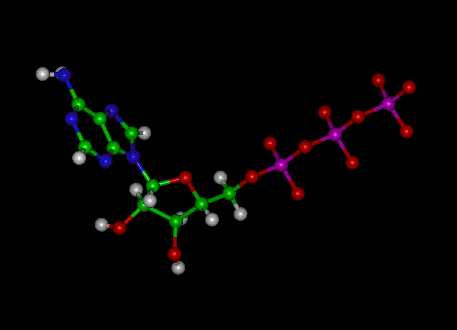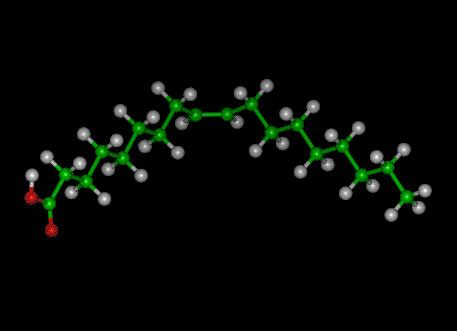
CHEM 2770 / MBIO 2770
Elements of Biochemistry I
CHEM 2770 Elements of Biochemistry 1 Cr. Hrs. 3 (Lab required) (Formerly 002.277) Basic concepts of biochemistry including the properties of biomolecules (amino acids and proteins, enzymes, carbohydrates, lipids, and nucleic acids) and aspects of energy production in cells. For students in Agricultural and Food Sciences, Human Ecology, and Four Year Biological Sciences programs in Science. May not be used as part of an Honours, Major, General, or Minor program in Chemistry or in Microbiology. This course is also given in Microbiology as MBIO 2770. Not be held with CHEM 2360, CHEM 2361 (002.236), MBIO 2360, MBIO 2361 (060.236), CHEM 2860 (002.286), or MBIO 2770 (060.277). Prerequisites: one of CHEM 1310, CHEM 1311 (002.131) (C), or CHEM 1320 (002.132) (C); plus six credit hours of university level biological sciences.
Announcements
Please read this important notice from the Faculty of Science: Registration Advisory.
Note also that Wednesday September 18 is the last day for adding courses and VW day is Monday November 18.
Students with disabilities should contact Student Accessibility Services (Email; Phone: 204-474-7423; Web) to facilitate the implementation of accommodations.
Please contact me if you wish to discuss the accommodations recommended by Student Accessibility Services.
Course Outline - 2019
Instructors:
- Dr. Joe O'Neil
- Room 390 Parker
- Telephone: 474-6697
- Office Hours: Open
- E-mail: Joe.ONeil@umanitoba.ca
- Dr. Ellert Nichols
- Room 406B Parker Chemistry Building
- Telephone: 474-7415
- Office Hours: TBA
- E-mail: Dr. Nichols
Lectures:
- Monday, Wednesday, & Friday 12:30-1:20 PM
- 408 Tier Building
Laboratories:
- Monday 2:30-5:30 PM
- Tuesday 8:30-11:30 AM
- Friday 2:30-5:30 PM
- 406, 416, 422 and 428 Parker
- IMPORTANT LABORATORY INFORMATION
You must attend the laboratory for which you are registered. Laboratories start the week of September 9, 2019.
Textbook:
- "Biochemistry - A Short Course, 4th edition" by: Tymoczko et al. Available in the Bookstore and also required for CHEM 2780 / MBIO 2780.
-
Laboratory Manual, 2018
Available in the Bookstore. - "Basic Concepts in Biochemistry: A Student's Survival Guide, 2nd Ed." by Hiram F. Gilbert
McGraw-Hill; ISBN 0-07-13567-6; QP 514.2 G56 2000
Lecture Notes:
Available at the UMLearn site.
Evaluation
| Mid-term Test - Tuesday October 22, 6:00-7:30 pm | 20% | Final Exam - Scheduled by Student Records | 50% | Optional:Sapling online assignments | 5% | Laboratory | 30% |
Exam Format
- Both the mid-term and final exams will consist of machine-marked, multiple-choice questions.
- Copies of midterm and final examinations from previous years are available below. Working through them will help prepare you for the examinations.
Lab Exemptions:
If you have taken the course within the last two years and obtained a grade of 70% on the laboratory reports you are eligible for a lab exemption when repeating the course for the first time. The lab mark will be carried over. For all subsequent attampts the lab must also be repeated. To obtain a lab exemption please fill in and submit a lab-exemption request form: Lab Exemption Request Form. Note that if you VW the course you will not be eligible for a lab exemption.
Continuation in CHEM 2780/MBIO 2780:
Students wishing to continue with CHEM 2780/MBIO 2780, Elements of Biochemistry II in second term MUST obtain a C grade or better in CHEM 2770/MBIO 2770. Students who have registered in CHEM 2780/MBIO 2780 and receive a D or F grade in CHEM 2770/MBIO 2770 MUST withdraw from CHEM 2780/MBIO 2780 as soon as possible after they are made aware of their grade.
Final Exam Review:
Students in the Faculty of Science are permitted to review their final exams before the deadline for appealing final grades (Final Grade Appeal). If you wish to view your final exam please fill in and submit an electronic application form: Final Exam Viewing Form.
Academic Integrity: All faculty and students at the University of Manitoba are expected to act with academic integrity. For information on this topic please visit the Faculty of Science web site Cheating, Plagiarism etc. and read the appropriate sections of the Academic Calendar and pages 7-8 and the inside cover of the lab manual.
ATP

Lecture Schedule
1. INTRODUCTION AND TYPES OF BIOLOGICAL MOLECULES (Chapter 1).
Students should read this chapter as a review of material covered in first-year courses in chemistry and biology.Entropy, enthalpy, and free energy.
Equilibrium constants.
2. WATER -- ITS EFFECT ON BIOMOLECULES (Chapter 2)
Buffers. Ionization of H2O, pH, weak and strong acids and bases.
Titration curves and pKa values. Calculations of pH. Use of Henderson-Hasselbalch Equation in calculations and making buffer solutions. Carbonic acid/bicarbonate buffer in blood.
3. AMINO ACIDS (Chapter 3)
Structure and classification according to R group. Selected chemical properties.
Stereochemistry, chirality, D- and L-forms, biological importance of chirality.
Ionic properties and titration curves of amino acids. Isoelectric pH (pI).
4. PEPTIDES & PROTEINS (Chapters 4 & 5).
Introduction to peptide & protein structure
Working with proteins
Covalent (Primary) Structure -- sequence determination
Three-dimensional structure The peptide bond; secondary structure and the forces maintaining it exemplified by the alpha-helix and beta-sheet .
Tertiary & quaternary structures and the forces maintaining them exemplified by globular and fibrous proteins.
Denaturation by heat, pH changes etc.
5. ENZYMES (Chapters 6-8)
General properties and classification.
Enzymes as catalysts -- the active or catalytic site, activation energy and reaction rates.
Enzyme kinetics: reaction rates, effects of enzyme concentration, pH, temperature, and substrate concentration. Michaelis-Menten equation, significance of Km and Vmax. Lineweaver-Burk (reciprocal) plots. Enzyme specificity.
How enzymes increase reaction rates: proximity and orientation effects, bond-stress, catalytic
R-groups and role of metal ions.
Enzyme inhibition: Reversible inhibition -- competitive and non-competitive inhibition. Irreversible inhibition.
Enzyme regulation: allosteric effects, feed-back inhibitors, activators. Sigmoidal kinetics. Regulation via covalent modification.
6. CARBOHYDRATES (Chapter 10)
Monosaccharides: Aldose and ketose nomenclature, stereochemistry, D-
and L-classification, enantiomers and epimers. Intramolecular hemiacetal
and hemiketal formations. Anomers. Mutarotation.
Sugar derivatives, glycosides.
Disaccharides: maltose, isomaltose, lactose, sucrose.
Reducing and non-reducing sugars.
Polysaccharides: Starch, glycogen, chitin and cellulose.
7. LIPIDS & MEMBRANES (Chapters 11 & 12)
Classification of lipids.
Structure & properties of fatty acids.
Structure & properties of triacylglycerols (fats and oils), waxes.
Membrane lipids: glycerophospholipids, sphingolipids (glycosphingolipids and gangliosides). Sterols and steroids, e.g. Cholesterol.
Amphipathic nature of membrane lipids.
Membranes: Composition. The Fluid-Mosaic model: bilayers, integral and perip heral proteins,
control of membrane fluidity through changes in fatty acid composition.
Asymmetric nature of membrane surfaces. Selectedunctions of membranes.
8. NUCLEOTIDES and NUCLEIC ACIDS (Chapter 33)
Purines and pyrimidines. Nucleosides, nucleotides. Ribo- and deoxyribonucleotides.
Polynucleotides and nucleic acids. RNA and DNA.
Structure of DNA: Chargaff’s rules, base pairing, the right-handed double-helical DNA and the forces stabilizing it. Some properties of DNA.
9. BIOENERGETICS (Chapter 15)
Spontaneous and non-spontaneous processes. Endergonic and exergonic processes. Standard free energy changes and equilibrium constants. Oxidation reduction reactions and reduction potential. Biological electron carriers.
ATP structure and properties as a "high-energy" phosphate. Low-energy phosphates. Free energies of hydrolysis as measure of phosphate transfer potentials. Other "high-energy" compounds.
Use of ATP in driving unfavorable reactions.
10. ATP PRODUCING PATHWAYS (Chapters 16 and 18-21)
Direct production via substrate level phosphorylation exemplified by anaerobic prpcesses (glycolysis, alcoholic fermentation) (Ch 16).
Indirect production involving aerobic degradation of glucose (and other foodstuffs) via acetyl-S-Coenzyme A: the TCA Cycle (Ch 18 & 19).
Electron transport and oxidative phosphorylation: Components and energetics of the electron-transport chain. Chemiosmotic theory & ATP yield (Ch 20 & 21).
Oleic Acid

Useful WWW Sites for CHEM 2770:
National Human Genome Research Institute
Return to the Chemistry Department Course Descriptions
Return to Joe O'Neil's Home Page
http://home.cc.umanitoba.ca/~joneil/CHEM2770.Course.outline.htm
by <The JavaScript Source
